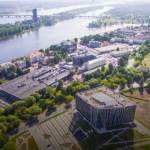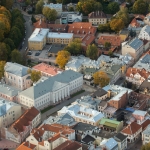The Turku Future Forum that was organized by the City of Turku during 28 November–1 December 2016 gathered together over 200 people to discuss and jointly develop ideas and scenarios for the development of the Campus and Science Park area. Most of the university and higher education functions are densely located around the city centre and the Kupittaa area. The Campus and Science Park area covers the present higher education campus and the coming new urban milieu towards the Kupittaa–Itäharju area.
During the week, citizens and stakeholders were invited to hear and ideate about the future of the area. The coming urban infill area is a former brownfield area and a huge potential for the city, and can be developed from the very beginning. The last day of the Forum on 1 December was dedicated to higher education.
Higher education day on 1 December
The event started with pitching the best six ideas of the Turku Kampus Upgrade competition to the Jury. In total, over 60 entries were submitted into the competition. The aim of the open competition was to craft nouveau ideas, how the higher education campus area could be developed here and now.
The afternoon continued with a future workshop, where people were encouraged to ideate, how Turku would become a world class student city by the year 2030. The Live Baltic Campus project team of University of Turku was actively involved in the planning and implementation of the workshop. The aim of the workshop was to find out significant improvements under the following themes:
– the student and international students services and their integration in the city
– desirability of the city as a student city, livability and wellbeing
– career guarantee on the region, academic employment and entrepreneurship.
Few examples of outcomes
The winning idea of the Turku Kampus Upgrade competition was an idea called Älyviitta – ”Smart signpost” – by Kimmo Tarkkanen. Orienteering on the campus area is challenging, especially for visitors. The Smart signposts would be located on the campus area, and they would benefit from the IoT technology. The smart signpost could also be tailored and personified in a way that it would change its signs for the particular person who is approaching it.
The future workshop generated also new ideas, and this was maybe the most brave one: A heavily trafficked motorway is dividing at the moment the biggest student housing area from the higher education campus area and the Kupittaa. At the same, the area lacks green infrastructures. There could be a green cover structure over the motorway that would work at the same as a light traffic route between the two areas.
Next steps
It seems that developing the Campus and Science Park area interests many people from the higher education sector which is a very positive sign. Also, City of Turku will strongly continue to develop the area. What could be improved at the moment is the continuity of the collaborative process, and also finding ways to actually implement the best new initiatives. The one thing that is still missing is a platform that would be an inspiring and open space, where the collaborative process could happen and cumulate.
The Turku Kampus Upgrade competition and the future workshop included many new ideas of jointly used spaces. The Live Baltic Campus pilot team in Turku can make good use of them and will connect the idea authors. The Live Baltic Campus pilot of Turku has been defined further and the design challenge at the moment is to find out ways to meet the students’s different space needs. There are also at the moment spaces on the campus that are underused or empty, and maybe could be used jointly. The task is now to find out what is the supply and demand for such spaces, and what could be the practice and the price tag for sharing them jointly.
By Johanna Aaltonen & Tiina Anttila, University of Turku, Turku pilot of Live Baltic Campus









